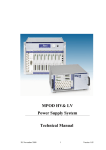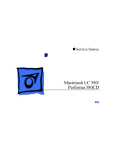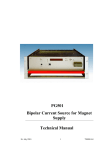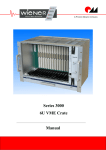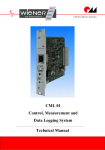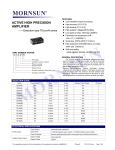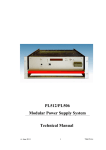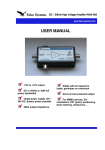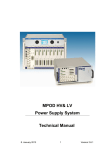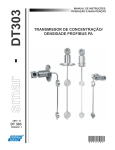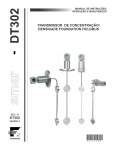Download Wiener MPOD manual
Transcript
MPOD-LV
Power Supply System
Technical Manual
15. April 2008
1
*00691.A0
General Remarks
The only purpose of this manual is a description of the product. It must not be interpreted as
a declaration of conformity for this product including the product and software.
W-Ie-Ne-R revises this product and manual without notice. Differences of the description in
manual and product are possible.
W-Ie-Ne-R excludes completely any liability for loss of profits, loss of business, loss of use
or data, interrupt of business, or for indirect, special incidental, or consequential damages of
any kind, even if W-Ie-Ne-R has been advises of the possibility of such damages arising
from any defect or error in this manual or product.
Any use of the product which may influence health of human beings requires the express
written permission of W-Ie-Ne-R.
Products mentioned in this manual are mentioned for identification purposes only. Product
names appearing in this manual may or may not be registered trademarks or copyrights of
their respective companies.
No part of this product, including the product and the software may be reproduced,
transmitted, transcribed, stored in a retrieval system, or translated into any language in any
form by any means with the express written permission of W-Ie-Ne-R.
Control Cabinet
In the context of this user manual, the control cabinet must fulfill the requirements on fireprotective enclosures according to EN 60950 / IEC 60950 / UL 60950.
All devices are intended for operation in control cabinets or in closed areas. The LAN
connection and all wire connections between the different system parts must be done via
shielded cable with conductive connector shells, which are fixed with screws.
Furthermore, an additional fire-protective enclosure is required which must not affect proper
air circulation.
15. April 2008
i
*00691.A0
Mains Voltage and Connection
The Power supplies are equipped with a “World”- mains input (rated voltage range: 100-240
VAC, frequency: 50-60 Hz, rated current: 16 A). Before connecting to the mains please
double-check correspondence.
Mains input connection at the power supply side is done with a 3-pin HIRSCHMANN
connector or power terminals. There is no main fuse inside. A circuit breaker for overcurrent
protection 16A, type B or C (EN / IEC 60898, VDE 0641), has to be installed externally.
Before disconnection the HIRSCHMANN connector, the power supply should be switched
into standby state. (Use the ON/OFF rocker switch at the fromt pannel of the MPOD
system.)
Hirschmann.
Signal
Description
Color of the Wire
Pin 1
L
Phase
black or brown
Pin 2
N
Return, Neutral
blue
Pin 3
Earth
not connected
PE
Protective Earth
green/yellow
Connection to Earth
Safety
After connecting the Power box to the mains, the mains input module is powered
permanently. Filter and storage capacitors of the power factor correction module are charged
with about 400VDC. Any DC-On-Signal as well as a power switch at control board (if any
installed) operates as a low voltage DC on/off switch only and not as a mains breaker.
Therefore it becomes dangerous if the box cover is open. In this case a lot of
components on high voltage potential get touchable!
Before starting any kind of work inside the power box remove the unit from
mains and wait a couple of minutes with your activities! Discharge the primary
DC Filter-capacitors by use of a well isolated 22 ohm 10W resistor.
We recommend in case of any malfunction to send the power box to Wiener or
to one of our representative for service
The backplane is connected to 385 V DC voltage. So never touch the backplane
or its connectors!
The HV-Modules produce very high voltage which may be mortal danger if
handled improperly. Please read the separate manuals of the HV modules for
detailed information!
15. April 2008
ii
*00691.A0
15. April 2008
iii
*00691.A0
Declaration of Conformity
Low Voltage Directive 73/23/EEC and EMC Directive Art. 10.1 of 89/336/EEC
W-Ie-Ne-R
Plein & Baus GmbH
declare under our own responsibility that the product
MPOD Power Supply System
Items: 0MPV.xxxx, 0BP0.9003, 0316.0070, 0R00.0002
is in accordance with the following standards or standardized documents:
1.
EN 60 950-1:2001
+ Corr:2004-09
2.
EN 61 000-6-3:2001
EN 55 022:1998
+ Corr:2001 + A1:2000 Kl. B
EN 55 022:1998
+ Corr:2001 + A1:2000 Kl. B
EN 61 000-3-2:2001
EN 61 000-3-3:1995 +Corr:1997 +A1:2001
EN 61 000-6-2:2001
EN 61 000-4-6:1996 + A1:2001
EN 61 000-4-3:1996 + A1:1998 + A2:2001
3.
EN 61 000-4-4:1995 + A1:2001
EN 61 000-4-5:1995 + A1:2001
EN 61 000-4-11:1994 + A1:2000
EN 61 000-4-2:1995 + A1:1998 + A2:2001
Niederspannungsrichtlinie [low voltage
directive]
Störaussendung EMA [RF emission]
Störspannung [conducted noise]
Störfeldstärke [radiated noise]
Oberschwingungen [harmonics]
Spannungsschwankungen [flicker]
Störfestigkeit EMB [immunity]
HF-Einströmung [injected HF currents]
HF-Felder [radiated HF fields] incl.
”900MHz”
Burst
Surge
Spannungs-Variationen [voltage
variations]
ESD
Conditions:
This unit is not a final product and is foreseen for use inside a closed cabinet. The supplying
of loads over long distances (>3m) needs possibly additional RF rejection hardware to get in
conformity of the definition.
Name and signature of authorized person
Place and Date
Manfred Plein
Techn. Director
April 2008
15. April 2008
iv
*00691.A0
Contents
Declaration of Conformity..............................................................................................iii
1 General Information.............................................................................................................1
1.1 Mpod Features ...........................................................................................................1
2 LV Modules.........................................................................................................................2
2.1 Odering Numbers........................................................................................................2
2.2 Sense & Control Connector Pin Assignment.............................................................3
2.3 Power Connector Pin Assignment..............................................................................4
3 HV Modules ........................................................................................................................4
4 Mpod Controller...................................................................................................................6
4.1 Odering Numbers........................................................................................................6
4.2 Software Setup.............................................................................................................6
4.3 Web Browser...............................................................................................................9
5 Power Supply.....................................................................................................................10
5.1 Odering Numbers......................................................................................................10
6 Mpod Crates.......................................................................................................................11
6.1 Odering Numbers......................................................................................................11
7 Power Box Data Sheet........................................................................................................12
8 Primary Powe Supply Data Sheet.......................................................................................15
9 MPOD Controller Data Sheet.............................................................................................16
15. April 2008
v
*00691.A0
Figures
Tables
15. April 2008
vi
*00691.A0
1
General Information
Mpod LX crate with mixed low and high voltage modules
1.1
Mpod Features
Mpod is a mainframe for multi-channel high voltage (HV) and low voltage (LV) power
supply modules. A unique flexibility is given by outfitting the MPOD crate with either the
LV or HV backplane only or with both to allow combined use of LV and HV modules. The
full size Mpod crate has 10 slots for power modules which provides a high number of output
channels. Its modular design makes the customer able to easily replace the fan tray, the
controller, the primary power supply or the optional air filter.
●
●
●
●
●
●
●
●
10 module slots for up to 80 LV channels / up to 320 HV channels
8U high for bottom cooling air intake, optional 9U high as desktop or front / side
intake with dust filter
Modules and controller outputs can be placed either at front or rear side (picture
above shows front side)
LV: 4/8 channels (0- 8/16/30/60V, 50W / channel, special modules up to 200V),
floating
HV: 320/160/80 channels (0- 2,5/4/6kV/8kV), channel- or module wise floating or
common ground
Low noise and ripple
Individually controlled output channels (voltage and current), programmable
warning and trip levels
MPOD Controller with Ethernet (TCP/IP) / CANbus / USB Combi-interface,
Interlock
15. April 2008
1
*00691.A0
Ethernet port with integrated Web server, programmable with SNMP protocol via
TCP/IP, OPC Server
● CE conform EN 50 081/82 part 1 (EN 50 022 B)
● safety in accordance with EN 60 950
● Sinusoidal mains current EN 61000-3-2
●
1.2
Mpod Crate - standard types
The following crate types are standardized configurations with 8U high chassis. Optionally a
filter frame is available with bottom or front air inlet which increases the height to 9U.
Other configurations and mixed system with part of the crate outfitted with PCI or VME
backplanes are available on request.
Type
Slots
Mpod EC
Mpod EC-R
Mpod LX
Mpod LX-R
Mpod EC-LV
Mpod EC-LV-R
Mpod EC-HV
Mpod EC-HV-R
Mpod 2H
Mpod 2H-R
Mpod 2H-LX
Mpod 2H-LX-R
10
10
10
10
10
10
10
10
10
10
10
10
Remote control Local control / Backplane
interface
display
Ethernet, CAN, USB
HV/LV
Ethernet, CAN, USB
HV/LV
Ethernet, CAN, USB Yes, LCD
HV/LV
Ethernet, CAN, USB Yes, LCD
HV/LV
Ethernet, CAN, USB
LV
Ethernet, CAN, USB
LV
Ethernet, CAN, USB
HV
Ethernet, CAN, USB
HV
Ethernet, CAN, USB
HV
Ethernet, CAN, USB
HV
Ethernet, CAN, USB Yes, LCD
HV
Ethernet, CAN, USB Yes, LCD
HV
HV
Output
power Position
600W
front
600W
rear
600W
front
600W
rear
front
rear
600W
front
600W
rear
1200W front
1200W
rear
1200W front
1200W
rear
(CAN-bus for HV modules only by disabling Ethernet communication)
Mpod LC-LV crate for low voltage modules
15. April 2008
2
*00691.A0
1.3
Mpod Mini crate
The WIENER Mpod mini crate represents a compact 19” rack mountable chassis for up to 4
Mpod low and high voltage modules. The Mpod mini crate includes the primary power
supply with 600W power for high voltage modules as well as a cooling system with high
performance DC fan. It can be outfitted with HV backplane for us as a high voltage system
only or with both HV and LV backplanes. The first half slot is reserved for the Mpod
Controller which manages the primary power supplies and provides Ethernet, USB and
CAN-bus interfaces for remote monitoring and control.
Mpod Mini crate with Mpod controller and 2 high voltage + 2 low voltage modules
15. April 2008
3
*00691.A0
2
LV Modules
The MPV Mpod Low Voltage modules are available with either 4 or 8 channels for different
voltage ranges with 8V, 16V, 30V, 60V maximum respectively. Special modules with up to
200V are under development.
All MVP modules have the following features:
6U height, 220mm deep fully shielded mechanics
All DC outputs floating with individual return lines, individually sensed
Low noise and ripple
Voltage and current settings / monitoring for each channel, 12 bit resolution
Current monitoring and limiting for each channel, 12 bit resolution
Programmable channel parameters:
○ voltage
○ current limit
○ power
○ ramping
○ group features
● programming and monitoring via Ethernet (TCP/IP) and USB
● Connectors: 2 x 8 pin high current sub-D, 37 pin sub-D for sense / control
●
●
●
●
●
●
Status LED's for all 8 channels
DC terminal channel 0 to 3
DC terminal channel 4 to 7
Sense and Control terminal
15. April 2008
4
*00691.A0
2.1
MPOD Low Voltage Module Versions
MPOD Low Voltage Series, 4 channels with floating ground
LV-Type Channels Voltage
Max
Peak power Resolution
Ripple
range
Current per channel
V, I
MPV 4008
4
0V ... 8V
10A
50W
12bit
<50mVpp (<3W)
<30mVpp (>3W)
MPV 4008L
4
0V ... 8V
5A
40W
12bit
<30mVpp (<3W)
<10mVpp (>3W)
MPV 4015
4
0V ... 16V
5A
50W
12bit
<50mVpp (<3W)
<30mVpp (>3W)
MPV 4015L
4
0V ... 16V
5A
40W
12bit
<30mVpp (<3W)
<10mVpp (>3W)
MPV 4030
4
0V ... 30V
2.5A
50W
12bit
<50mVpp (<3W)
<30mVpp (>3W)
MPV 4030L
4
0V ... 30V
2.5A
50W
12bit
<30mVpp (<3W)
<10mVpp (>3W)
MPV 4060
4
0V ... 60V
1A
50W
12bit
<50mVpp (<3W)
<30mVpp (>3W)
MPV 4060L
4
0V ... 60V
1A
50W
12bit
<30mVpp (<3W)
<10mVpp (>3W)
MPOD Low Voltage Series, 8 channels with floating ground
LV-Type Channels Voltage
Max
Peak power Resolution
Ripple
range
Current per channel
V, I
MPV 8008
8
0V ... 8V
10A
50W
12bit
<50mVpp (<3W)
<30mVpp (>3W)
MPV 8008L
8
0V ... 8V
5A
40W
12bit
<30mVpp (<3W)
<10mVpp (>3W)
MPV 8015
8
0V ... 16V
5A
50W
12bit
<50mVpp (<3W)
<30mVpp (>3W)
MPV 8015L
8
0V ... 16V
5A
40W
12bit
<30mVpp (<3W)
<10mVpp (>3W)
MPV 8030
8
0V ... 30V
2.5A
50W
12bit
<50mVpp (<3W)
<30mVpp (>3W)
MPV 8030L
8
0V ... 30V
2.5A
50W
12bit
<30mVpp (<3W)
<10mVpp (>3W)
MPV 8060
8
0V ... 60V
1A
50W
12bit
<50mVpp (<3W)
<30mVpp (>3W)
MPV 8060L
8
0V ... 60V
1A
50W
12bit
<30mVpp (<3W)
<10mVpp (>3W)
15. April 2008
5
*00691.A0
2.2
Sense & Control Connector Pin Assignment
Some pins are reserved for future functionality.
DSUB37 male
(Channel 0..7)
Pin
1
20
2
21
3
22
4
23
5
24
6
25
7
26
8
27
9
28
10
29
11
30
12
31
13
32
14
33
15
34
16
35
17
36
18
37
19
15. April 2008
Signal
Comment
S0+
S0-
Channel 0 positive Sense Input
Channel 0 negative Sense Input
reserved
reserved
Channel 1 positive Sense Input
Channel 1 negative Sense Input
reserved
reserved
Channel 2 positive Sense Input
Channel 2 negative Sense Input
reserved
reserved
Channel 3 positive Sense Input
Channel 3 negative Sense Input
reserved
reserved
Channel 4 positive Sense Input
Channel 4 negative Sense Input
reserved
reserved
Channel 5 positive Sense Input
Channel 5 negative Sense Input
reserved
reserved
Channel 6 positive Sense Input
Channel 6 negative Sense Input
reserved
reserved
Channel 7 positive Sense Input
Channel 7 negative Sense Input
reserved
reserved
reserved
reserved
reserved
reserved
reserved
S1+
S1S2+
S2S3+
S3S4+
S4S5+
S5S6+
S6S7+
S7-
6
*00691.A0
2.3
Power Connector Pin Assignment
DSUB37-8 female
(Channel 0..3)
DSUB37-8 female
(Channel 4..7)
15. April 2008
Pin
Signal
Comment
1 U0+
Channel 0 positive Output
2 U0-
Channel 0 negative Output
3 U1+
Channel 1 positive Output
4 U1-
Channel 1 negative Output
5 U2+
Channel 2 positive Output
6 U2-
Channel 2 negative Output
7 U3+
Channel 3 positive Output
8 U3-
Channel 3 negative Output
Pin
Signal
Comment
1 U4+
Channel 4 positive Output
2 U4-
Channel 4 negative Output
3 U5+
Channel 5 positive Output
4 U5-
Channel 5 negative Output
5 U6+
Channel 6 positive Output
6 U6-
Channel 6 negative Output
7 U7+
Channel 7 positive Output
8 U7-
Channel 7 negative Output
7
*00691.A0
3
HV Modules
MPOD high voltage modules are manufactured by ISEG. For technical details please refer to
the ISEG manuals and data sheets of the EHQ, EHS and EDS multi channel high voltage
modules. General features are:
●
●
●
●
●
●
●
●
High Voltage modules with 8, 16 or 32 individually controlled channels
Maximum voltage range from 500V up to 6 kV
Extremely low noise and ripple: <5mVpp to <10mVpp
All DC outputs floating or common ground depending on module type
Voltage and current settings / monitoring for each channel, 16 to 21 bit resolution
Current monitoring and limiting for each channel, 16 to 21 bit resolution
Programmable channel parameters, group features
output connectors:
8 channel modules
SHV or REDEL (<4kV) multi pin
16 channel modules
SHV or REDEL (<4kV) multi pin
32 channel modules
REDEL multi pin
16, 32 and 8 channel ISEG high voltage modules (from left to right) with Redel multipin
connectors and SHV
15. April 2008
8
*00691.A0
EHS Series, 8 / 16 channels with common ground
Type
Channels V max I max
V res
EHS 8060x_105
8
6kV
1mA 10-5 - 10-6 Vmax
EHS 8040x_205
8
4kV
2mA 10-5 - 10-6 Vmax
EHS 8030x_305
8
3kV
3mA 10-5 - 10-6 Vmax
EHS 8020x_405
8
2kV
4mA 10-5 - 10-6 Vmax
EHS 8010x_805
8
1kV
8mA 10-5 - 10-6 Vmax
EHS 8005x_156
8
500V 15mA 10-5 - 10-6 Vmax
EHS F060x_105
16
6kV
1mA 10-5 - 10-6 Vmax
EHS F040x_205
16
4kV
2mA 10-5 - 10-6 Vmax
EHS F030x_305
16
3kV
3mA 10-5 - 10-6 Vmax
EHS F020x_405
16
2kV
4mA 10-5 - 10-6 Vmax
EHS F010x_805
16
1kV
8mA 10-5 - 10-6 Vmax
EHS F005x_156
16
500V 15mA 10-5 - 10-6 Vmax
I res
10-5 - 10-6 Imax
10-5 - 10-6 Imax
10-5 - 10-6 Imax
10-5 - 10-6 Imax
10-5 - 10-6 Imax
10-5 - 10-6 Imax
10-5 - 10-6 Imax
10-5 - 10-6 Imax
10-5 - 10-6 Imax
10-5 - 10-6 Imax
10-5 - 10-6 Imax
10-5 - 10-6 Imax
Ripple
<50 mV
<5mV
<5mV
<5mV
<5 mV
<5mV
<50mV
<5mV
<5 mV
<5mV
<5mV
<5mV
EHS Series, 8 / 16 channels with floating ground
Type
Channels V max I max
V res
EHS 8660x_105-F
8
6kV
1mA 10-5 - 10-6 Vmax
EHS 8640x_205-F
8
4kV
2mA 10-5 - 10-6 Vmax
EHS 8630x_305-F
8
3kV
3mA 10-5 - 10-6 Vmax
EHS 8620x_405-F
8
2kV
4mA 10-5 - 10-6 Vmax
EHS 8610x_805-F
8
1kV
8mA 10-5 - 10-6 Vmax
EHS 8605x_156-F
8
500V 15mA 10-5 - 10-6 Vmax
EHS F660x_105-F
16
6kV
1mA 10-5 - 10-6 Vmax
EHS F640x_205-F
16
4kV
2mA 10-5 - 10-6 Vmax
EHS F630x_305-F
16
3kV
3mA 10-5 - 10-6 Vmax
EHS F620x_405-F
16
2kV
4mA 10-5 - 10-6 Vmax
EHS F610x_805-F
16
1kV
8mA 10-5 - 10-6 Vmax
EHS F605x_156-F
16
500V 15mA 10-5 - 10-6 Vmax
I res
10-5 - 10-6 Imax
10-5 - 10-6 Imax
10-5 - 10-6 Imax
10-5 - 10-6 Imax
10-5 - 10-6 Imax
10-5 - 10-6 Imax
10-5 - 10-6 Imax
10-5 - 10-6 Imax
10-5 - 10-6 Imax
10-5 - 10-6 Imax
10-5 - 10-6 Imax
10-5 - 10-6 Imax
Ripple
<50mV
<10mV
<10mV
<10mV
<10mV
<10mV
<50mV
<10mV
<10mV
<10mV
<10mV
<10mV
EHQ Series high precision series, 8 / 16 channels with floating ground
Type
Channels V max I max
V res
I res
EHQ 8210x_505-F
8
1kV
5mA
1mV
5nA
EHQ 8205x_156-F
8
500V 15mA
0.5mV
15nA
EHQ F210x_505-F
16
1kV
5mA
1mV
5nA
EHQ F205x_106-F
16
500V 10mA
0.5mV
15nA
Ripple
<5mV
<5mV
<5mV
<5mV
EDQ Distribution Series, 16 / 32 channels with common ground
Type
Channels V max I max
V res
I res
EDS F030x_504
16
3kV 500uA
60mV
10-5 - 10-6 Imax
EDS F005x_105
16
500V
1mA
10mV
10-5 - 10-6 Imax
EDS 20030x_504
32
3kV 500uA
60mV
10-5 - 10-6 Imax
EDS 20005x_105
32
500V
1mA
10mV
10-5 - 10-6 Imax
Ripple
<10mV
<10mV
<10mV
<10mV
15. April 2008
*00691.A0
9
4
Mpod Controller
The Mpod controller which is plugged into the first half slot of the crate controls the primary
power supply as well as all inserted LV- and HV-modules. Further it connects these to
remote controlling interfaces / services in an unique way.
Mpod Controller features:
●
TCP/IP 10M/100M port, auto ranging
●
Built-in HTTP server
●
TCP/IP protocol with SNMP v.2c for full control of all module parameters
●
2 CAN-Bus ports, wired in parallel for daisy-chaining
●
USB 2 interface
●
3 status LED's
●
Interlock connector
Status LED's
USB 2 port
Ethernet port
2 CANbus ports
Interlock connector
15. April 2008
10
*00691.A0
Ethernet port, standard NIC pin layout
RJ45
Pin
1
2
3
4
5
6
7
8
Signal
TX+
TXRX+
GND 1
GND 1
RXGND 2
GND 2
Comment
Pin
1
2
3
4
5
6
7
8
Signal
CAN-H
CAN-L
GND
n.c.
n.c.
reserved
GND
n.c.
Comment
75 Ohm
75 Ohm
CAN-bus ports
RJ45
15. April 2008
11
*00691.A0
5
5.1
Remote Control / Software
Software Setup for Microsoft Windows
Before the Mpod Controller can be used, it has to be configured according to the network
environment.
This is done by the MUSEcontrol utility, which allows access to the USB-port of the Mpod
Controller with a computer running Windows XP. The software is free available on the
download area at www.wiener-d.com. Run the MUSEControl.msi Program to install all
drivers and the USB program itself. It is recommended to define a short path for the driver
location during installation. Connecting the MPOD Controller via USB it should be
automatically detected and the Silicon Labs USB drivers (SiLib.sys and SiUSBXp.sys)
loaded
Starting the program, the main window gives a quick overview of the Mpod and its
connected LV-Modules.
In case no low voltage modules are located in the crate an error message “No module found”
will pop up which should be ignored. To prepare the MPOD controller select System →
Configuration which starts the network configuration dialog.
Here you enter the TCP/IP network settings (IP address, subnet mask and default gateway).
You have to use the parameters of your local network here. Please contact your network
administrator for details.
15. April 2008
12
*00691.A0
HTTP and SNMP port numbers should
only modified if you know what you
do. Setting any ports to 0 disables the
server.
The “First LV Slot” item is an
intermediate solution to define the slot
number of the first LV-module. Any
HV-module plugged into this slot will
not be detected. (This setting is
necessary because the LV modules do
not use geographic addressing to detect
their slot number automatically in the
moment)
Another essential menu item is the
System → FirmwareUpdate which
starts
the
firmware
update
procedures.
Low Voltage channels can be completely programmed and monitor within the
MUSE application. You can switch on or off any channel by clicking at the line of the
channel. If you click with the right mouse button, the “OutputConfiguration” dialog is
entered:
The dialog is divided into five main sections:
Measurement
Shows the actual measured
sense voltage, terminal
voltage (at the module
terminals), current, the
calculated power and the
most
critical
module
temperature.
● Control & Status
Here the channel can be
switched on and off. If the
channel has switched off
because of any failure, the
reason is displayed here,
too.
● Nominal Values
Here the nominal output
voltage (sense voltage),
current limit and ramping
speeds are entered. The “No
Ramp at Switch Off” check
box forces immediate
switch off. The regulation
mode can be optimized for
different cable lengths (slow
regulation requests both
check boxes to be checked!)
● Supervision
Here the threshold values of
the minimum sense voltage,
the maximum sense voltage, the maximum terminal voltage, the maximum current,
15. April 2008
13
*00691.A0
●
the maximum power, the maximum temperature and the communication timeout can
be entered. The right column “maximum” can only be changed by this utility and is
the maximum allowed value of the left column. The left column may be changed
here or via the TCP/IP network.
The most right column “on failure” defines the action if the associated threshold is
exceeded.
The “communication timeout” at the last low is an internal timeout of the
communication between different processors. If the processor responsible for a
specific output has no data from it's master processor for longer than this time (in
milliseconds), the output channel will be switched off.
● Identification
Here the group number of this channel can be entered.
Other main menu items associated with this dialog are “Start/Stop” (stop and restart the
communication with the Mpod controller via USB) and “SelectOutput”, which simple
increments the channel number which is displayed by the other dialogs.
The other main menu items are used for test and maintenance and should not used by the
customer.
5.2
Web Browser
With the integrated WWW browser it is possible to get an overview of all channels in a
simple way.
15. April 2008
14
*00691.A0
5.3
NetSNMP
NETSNMP is an open source SNMP program which can be used to access the Mpod
controller via the Simple Network Management Protocol. Please
see http://netsnmp.sourceforge.net/ for more details.
Please install NETSNMP from the CD-ROM or downloaded from WIENER support web
site on the control computer. In order to perform SNMP calls from any WIENER product the
WIENER-CRATE-MIB file must be stored somewhere on the PC doing the calls, by default
that location should be /usr/share/snmp/mibs (Windows: C:\usr\share\snmp\mibs).
A fast an easy way to begin using SNMP is to use command line arguments. The command
line arguments specified in this document are based on the netSNMP, an open source library
for SNMP support. The command line syntax is the same for both windows and Linux (and
probably MAC OSX).
The most common kind of call you will want is to get data from the power supply. This is
easily done via the snmpget command. The example below retrieves information about
whether the main power for the crate is on. If you wish to test this example on your own
system replace “$path” with the path to WIENER-CRATE-MIB.txt (/usr/share/snmp/mibs
by default and “$ip” with the ip address of your MPOD (see following examples).
snmpget -v 2c -M $path -m +WIENER-CRATE-MIB -c public $ip sysMainSwitch.0
WIENER-CRATE-MIB::sysMainSwitch.0 = INTEGER: OFF(0)
This indicates that the MPOD crate is currently off. To better understand the call above we
will break it down by parameter:
snmpget: This command will retrieve a value about the MPOD crate or one of the
channels it houses..
-v 2c: This parameters specifies which version of the SNMP to use. WIENER
devices use SNMP 2C.
-M $path: This parameter should be replaced with the path to the WIENERCRATE-MIB.txt file.
-m +WIENER-CRATE-MIB: This parameter tells the command to look at the
WIENER-CRATE-MIB to resolve the OID name.
-c public: This specifies which community of values can be accessed.
$ip: This should be replaced with the IP address of the MPOD crate.
sysMainSwitch.0:
This is the register you wish to retrieve.
Since we we know from the call above that the crate is off, we may want to turn it on.
(Software power cycling is only possible of the green mains switch on the MPOD is “ON”,
this is to prevent a remote user to override a local user and adds a level of safety to the unit.)
To turn MPOD on, we can use the command:
snmpset -v 2c - path -m +WIENER-CRATE-MIB -c public $ip sysMainSwitch.0 i 1
Most of the parameters for snmpset are the same as snmpget, the new parameters are
highlighted below.
i: Since sysMainSwitch.0 is an integer value, we specify the value to be an integer
with.
15. April 2008
15
*00691.A0
1: This is the value we wish to write. In this case we write ‘one’ to set the main
switch to on.
A list of all available parameters or sub-parameters as for instance channels can be obtained
using the command snmpwalk. To get all parameters use:
snmpwalk -Cp -Oqv -v 2c -M $path -m +WIENER-CRATE-MIB -c guru $ip
The following command provides a list of all existing output channels:
snmpwalk -Cp -Oqv -v 2c -M $path -m +WIENER-CRATE-MIB -c guru $ip outputName
U0
….
U3
U100
U101
…..
U107
Variables found: 12
This example returns 12 index numbers. The first 4 channels, U0-U3, come from the LV
module in slot 0. The second group of channels, U100-U107, comes from the module in slot
Please note the following geographic module / channel number coding for the SNMP call
indexes, where the first digit is defined by the slot number and the following two by the
channel of the particular module in this slot:
Slot
1
2
...
10
Channel
0 to 98
0 to 98
...
0 to 98
Name
Uxx
U1xx
...
U9xx
index
.001 to .099
.101 to .199
...
.901 to .999
After obtaining a list of channels, it is useful to be able to write or read information about
that channel. This can be done using the snmpget and snmpset commands. For example, to
write channel U0 set point to 200V:
snmpset -v 2c -M $path -m +WIENER-CRATE-MIB -c guru $ip outputVoltage.U0 F 200
Note the “F” before the 200, this indicates that the value is a floating point number. This
value can be read back via:
snmpget -Oqv -v 2c -M $path -m +WIENER-CRATE-MIB -c guru $ip outputVoltage.U0
A complete list of values that can be written or read via SNMP can be found in the
WIENER-CRATE-MIB but commonly needed values are:
Value Name
outputVoltage
outputCurrent
outputMeasurementSenseVoltage
outputMeasurementCurrent
outputSwitch
outputVoltageRiseRate
outputStatus
15. April 2008
Type
Float
Float
Float
Float
Integer
Float
Bits
Access
R/W
R/W
R
R
R/W
R/W
R
16
Comments
The Channel set Voltage
The channel current limit
Actual channel Voltage
Actual channel current
Turns channel ON/OFF
Channel ramp rate
Channel Status information
*00691.A0
Turning Channels ON/OFF - The individual channels of an MPOD system can be turned on
or off using simple snmpset commands. To turn on channel Ux:
snmpset -Oqv -v 2c -M $path -m +WIENER-CRATE-MIB -c guru $ip outputSwitch.Ux i 1
The same channel can be turned off with:
snmpset -Oqv -v 2c -M $path -m +WIENER-CRATE-MIB -c guru $ip outputSwitch.Ux i 0
The following examples can be used as an introduction into the SNMP programming of
Mpod modules. All calls are shown with the response lines. For details please refer to the
Mpod command list or see the MIB file.
1) to see all available parameter type in the terminal window with corrected IP address. This
will list all existing parameters.:
snmpwalk -v 2c -m +WIENER-CRATE-MIB -c public 192.168.2.25 crate
2) To list just the Output names use:
snmpwalk -v 2c -m +WIENER-CRATE-MIB -c public 192.168.2.25 outputName
return for MPOD system with 2 ISEG EHS HV modules (8 channels each) in slot 2 and 3:
WIENER-CRATE-MIB::outputName.101 = STRING: U100
WIENER-CRATE-MIB::outputName.102 = STRING: U101
WIENER-CRATE-MIB::outputName.103 = STRING: U102
WIENER-CRATE-MIB::outputName.104 = STRING: U103
WIENER-CRATE-MIB::outputName.105 = STRING: U104
WIENER-CRATE-MIB::outputName.106 = STRING: U105
WIENER-CRATE-MIB::outputName.107 = STRING: U106
WIENER-CRATE-MIB::outputName.108 = STRING: U107
WIENER-CRATE-MIB::outputName.201 = STRING: U200
WIENER-CRATE-MIB::outputName.202 = STRING: U201
WIENER-CRATE-MIB::outputName.203 = STRING: U202
WIENER-CRATE-MIB::outputName.204 = STRING: U203
WIENER-CRATE-MIB::outputName.205 = STRING: U204
WIENER-CRATE-MIB::outputName.206 = STRING: U205
WIENER-CRATE-MIB::outputName.207 = STRING: U206
WIENER-CRATE-MIB::outputName.208 = STRING: U207
3) To see all Output channel set voltages:
snmpwalk -v 2c -m +WIENER-CRATE-MIB -c p ublic 192.168.2.25 outputVoltage
returns for MPOD system with one 8 channel ISEG EHS HV module in slot 3:
WIENER-CRATE-MIB::outputVoltage.201 = Opaque: Float: 0.000000 V
WIENER-CRATE-MIB::outputVoltage.202 = Opaque: Float: 0.000000 V
WIENER-CRATE-MIB::outputVoltage.203 = Opaque: Float: 0.000000 V
WIENER-CRATE-MIB::outputVoltage.204 = Opaque: Float: 0.000000 V
WIENER-CRATE-MIB::outputVoltage.205 = Opaque: Float: 0.000000 V
WIENER-CRATE-MIB::outputVoltage.206 = Opaque: Float: 0.000000 V
WIENER-CRATE-MIB::outputVoltage.207 = Opaque: Float: 0.000000 V
WIENER-CRATE-MIB::outputVoltage.208 = Opaque: Float: 0.000000 V
4) Read individual set voltages:
15. April 2008
17
*00691.A0
snmpget -v 2c -m +WIENER-CRATE-MIB -c public 192.168.2.25 outputVoltage.001
WIENER-CRATE-MIB::outputVoltage.u0 = Opaque: Float: 0.000000 V
5) Write and read individual set voltages, “guru” access needed to write!
snmpset -v 2c -m +WIENER-CRATE-MIB -c guru 192.168.2.25 outputVoltage.101 F 200
WIENER-CRATE-MIB::outputVoltage.101 = Opaque: Float: 200.000000 V
snmpget -v 2c -m +WIENER-CRATE-MIB -c public 192.168.2.25 outputVoltage.101
WIENER-CRATE-MIB::outputVoltage.101 = Opaque: Float: 200.000000 V
6) Write and read set voltage ramp, “guru” access needed to write, for ISEG modules with
common ramp the channel-ID can be any channel of the module!
snmpset -v 2c -m +WIENER-CRATE-MIB -c guru 192.168.2.25 outputVoltageRiseRate.
101 F 10
WIENER-CRATE-MIB::outputVoltageRiseRate.101 = Opaque: Float: 10.000000 V/s
snmpget -v 2c -m +WIENER-CRATE-MIB -c public 192.168.2.25 outputVoltageRiseRate.
101
WIENER-CRATE-MIB::outputVoltageRiseRate.101 = Opaque: Float: 10.000000 V/s
5.4
A BASH Simple Script for SNMP
All of the commands above could be combined into scripts to set and monitor a predefined
set of channels. For example a Bash script to read all channels and set the voltages and
current limit to the same value for each channel could look like:
#!/bin/bash
# Simple Bash Script that will read and set all channels in a MPOD crate
ip=192.168.2.25
path=/usr/share/snmp/mibs
setVoltage=5
setCurrent=.100
setStatus=1
setRamp=100
channelCount=$(snmpget -Oqv -v 2c -M $path -m +WIENER-CRATE-MIB -c guru $ip
outputNumber.0)
indices=$(snmpwalk -Oqv -v 2c -M $path -m +WIENER-CRATE-MIB -c guru $ip
outputIndex)
x=(`echo $indices | tr ' ' ' '`)
COUNTER=0
while [ $COUNTER -lt $channelCount ]; do
index=$(echo ${x[${COUNTER}]})
voltage=$(snmpset -OqvU -v 2c -M $path -m +WIENER-CRATE-MIB -c guru $ip
outputVoltage.$index F $setVoltage)
iLimit=$(snmpset -OqvU -v 2c -M $path -m +WIENER-CRATE-MIB -c guru $ip
outputCurrent.$index F $setCurrent)
rampspeed=$(snmpset -OqvU -v 2c -M $path -m +WIENER-CRATE-MIB -c guru $ip
outputVoltageRiseRate.$index F $setRamp)
15. April 2008
18
*00691.A0
status=$(snmpset -OqvU -v 2c -M $path -m +WIENER-CRATE-MIB -c guru $ip
outputSwitch.$index i $setStatus)
voltage=$(snmpget -OqvU -v 2c -M $path -m +WIENER-CRATE-MIB -c guru
outputVoltage.$index)
iLimit=$(snmpget -OqvU -v 2c -M $path -m +WIENER-CRATE-MIB -c guru
outputCurrent.$index)
sense=$(snmpget -OqvU -v 2c -M $path -m +WIENER-CRATE-MIB -c guru
outputMeasurementSenseVoltage.$index)
current=$(snmpget -OqvU -v 2c -M $path -m +WIENER-CRATE-MIB -c guru
outputMeasurementCurrent.$index)
rampspeed=$(snmpget -OqvU -v 2c -M $path -m +WIENER-CRATE-MIB -c guru
outputVoltageRiseRate.$index)
status=$(snmpget -OqvU -v 2c -M $path -m +WIENER-CRATE-MIB -c guru
outputSwitch.$index)
$ip
$ip
$ip
$ip
$ip
$ip
echo "$voltage $iLimit $sense $current $rampspeed $status"
let COUNTER=COUNTER+1
done
15. April 2008
19
*00691.A0
5.5
Mpod SNMP Parameter List
Parameter
sysMainSwitch
sysStatus
sysVmeSysReset
outputNumber
groupsNumber
outputName
outputGroup
outputStatus
outputMeasurementSenseVoltage
outputMeasurementTerminalVoltage
outputMeasurementCurrent
outputMeasurementTemperature
outputSwitch
outputVoltage
outputCurrent
outputVoltageRiseRate
outputVoltageFallRate
outputSupervisionBehavior
outputSupervisionMinSenseVoltage
outputSupervisionMaxSenseVoltage
outputSupervisionMaxTerminalVoltage
outputSupervisionMaxCurrent
outputSupervisionMaxTemperature
outputConfigMaxSenseVoltage
outputConfigMaxTerminalVoltage
outputConfigMaxCurrent
outputConfigMaxPower
sensorNumber
sensorTemperature
sensorWarningThreshold
sensorFailureThreshold
snmpCommunityName
psFirmwareVersion
psSerialNumber
psOperatingTime
psDirectAccess
fanFirmwareVersion
fanSerialNumber
fanOperatingTime
fanAirTemperature
fanSwicthOffDelay
fanNominalSpeed
fanNumberOfFans
fanSpeed
15. April 2008
Multi
1
1
1
1
1
320
320
320
320
320
320
320
320
320
320
320
320
320
320
320
320
320
320
320
320
320
320
1
12
12
12
4
1
1
1
1
1
1
1
1
1
1
1
6
20
Access
R/W
R/W
R/W
R
R
R
R
R
R
R
R
R
R/W
R/W
R/W
R/W
R/W
R/W
R/W
R/W
R/W
R/W
R/W
R
R
R
R
R
R
R/W
R/W
R/W
R
R
R
R/W
R
R
R
R
R/W
R/W
R
R
Type
i
i
i
i
i
str
i
i
F
F
F
i
i
F
F
F
F
i
F
F
F
F
i
F
F
F
F
i
i
i
i
str
str
str
i
string
string
string
i
i
i
i
i
i
*00691.A0
5.6
LabView Control Program (NETSNMP)
The LabView Control program VI's SNMP_MPOD_xxx.vi allow controlling both low
and high voltage channels for small configurations of a few Mpod modules. The
program can run in parallel to web monitoring.
All LabView MPOD function VI’s are using SNMP calls from the
WIENER_SNMP_Basic.dll. This DLL requires NETSNMP and the WIENER –CRATEMIB.txt file as described above!
Please run SNMP_MPOD_xxx.vi with either LabView 8.0 / 8.2 or 8.5.
Example for LabView VI for 4 channel low voltage module
Example for LabView VI for 8 channel high voltage module
5.7
C++ programming (NETSNMP)
Using NETSNMP C++ programs can be easily written for monitoring and control of Mpod
low / high voltage modules. For Windows all needed functions are provided by a
dynamically loadable library.
15. April 2008
21
*00691.A0
6
Mpod Crate
Powered chassis for multi-channel low and high voltage modules
Construction
Features,
Accessories:
Accessories:
7
8 or 9U x 19” crate
max.10 modules, up to3 kW / 3,6kW
output power
Connections / plugs:
24 female pins 80A, parallel used for
higher currents, 3 x 9pin Sub D for
sensing (each for 4 channels)
Dimensions (w, h, d)
434 mm x 132 mm x 325 mm
Weight:
31,5 kg
19" Power Bin for plug inMARATON power supplies. 24 power
contacts with M5 threated bolts and sense terminals at rear side.
Primary Power Supply
ToDo!!!!
The power supply provides all necessary supply voltages for the LV- and HV-Modules.
It is connected to the mains (World wide input 100..240V AC, 50..60 Hz).
7.1
●
World wide input: 100..240V AC, 50..60 Hz, single phase
●
Sinusoidal current input, up to 16A, depending on the used modules
Power Box Data Sheet
3U box with max. 6 power modules.
Input:
Rated Input Voltage:
Rated Input Current:
Output Insulation (SELF)
385 V DC +/- 10 V
11 A
CE
EN 60950 , ISO 380, VDE 0805, UL 1950, C22.2.950
Mains Input
AC Input:
power fact. >0,98
CE
100- 240VAC / 16A +/-10% (20A peak), 47-63Hz,
Inrush current:
(cold unit)
limited by soft start-circuit to 110% of nominal current
Input protection:
Circuit breaker with 20A thermal overload protection
(16 A at maximum operating temperature) included.
Power Output:
converter
385 V DC +/- 5V, matched for MARATON DC/DC
230VAC input
continuously 9A, 3500W nominal (4,4kW peak) @
Regulation:
Load (10-90%)
Mains (10-90%)
1% deviation
1% deviation
Output ripple:
frequency)
Load (10-90%)
1-10Vss 94-126Hz (double mains
RF rejection:
EN 55 022 Class B, Input and Output
Output protection
15. April 2008
22
*00691.A0
overload:
current limiting for booster circuits, 90°C cut off
temperature
Dimensions:
4U x 14 PU width acc. to IEC 60297, 450 mm deep
Weight:
4,7 kg
Module connectors:
2mm pin / socket diameter.
max. ratings: 25A up to 50°C, 500V. 2,2kV test
voltage 50Hz
PE / Ground pins outfitted as leading pin
EMC Compatibility /RFI Rejection
Separate Input and Output EMC Filter
EM
EN61000-6-3:2001
[RF emission]
A
EM
EN55022:1998 + Corr:2001 + A1:2000 ClassB
EN55022:1998+ Corr:2001 + A1:2000 ClassB
EN61000-3-2:2001
EN61000-3-3:1995 +Corr:1997 +A1:2001
EN61000-6-2:2001
conducted noise
radiated noise
harmonics
flicker
[immunity]
EN61000-4-6:1996 + A1:2001
EN61000-4-3:1996 +A1:1998 + A2:2001
EN61000-4-4:1995 + A1:2001
EN61000-4-5:1995 + A1:2001
EN61000-4-11:1994 + A1:2000
EN61000-4-2:1995 + A1:1998 + A2:2001
injected HF currents
radiated HF fields incl. 900MHz
Burst
Surge
voltage variations
ESD
B
Operation temperature:
0....50°C without derating, storage: -30°C … + 85°C
Efficiency:
better than 95 %
MTBF
electronics:
40°C ambient: ca. 100 000 h
integrated fan:
40°C ambient: ca. 65 000 h, 25° ambient >85000h
15. April 2008
23
*00691.A0
8
Mpod Low Voltage module data sheet
Regulation fast remote sense circuit (short sensed distance, sense connected to output
at the MPOD module):
Static:
Dynamic (0.5 m
wire):
Recovery Time:
Conditions
MVP 2-8 V / 30–60 V
< 15 mV
(+/-100% load, +/- full
mains range)
MVP other voltages
< 0.05 %
(+/-100% load, +/- full DC
input range)
MVP 2-8 V
< 100 mV
(50 % - 75 % load change)
other
< 0.7 %
(50 % - 75 % load change)
MVP 2-8V
1%: 0.2 ms (50 % - 75 % load change)
0.1%: 0.5 ms
MVP 5-16V, 7-24V
1%: 0.0 ms (50 % - 75 % load change)
0.1%: 1.0 ms
MVP 30-60V
1%: 0.5 ms (50 % - 75 % load change)
0.1%: 1.0 ms
Current slope <1000A/ms, 20mF per 100A parallel to load
Regulation slow remote sense circuit (long sensed distance):
Static:
Dynamic:
MVP 2-8V/ 30-60V
< 15 mV
(+/-100% load, +/- full
mains range)
Other
< 0.05 %
(+/-100% load, +/- full
mains range)
Dynamic deviation depends on current slope resp. filter capacitors at
load side only
30m cable to load, 0,3mF capacitance at load side, 1V drop at
nominal load, 10% - 90 % load change with 3ms slope (50A
output= 13,33A/ms) leads to less than 10% temporary output
voltage deviation
Recovery Time (40m MVP 2-7V, 2-8V
wire, 5V at load side,
Udrop < 2 V:
Other
10%: <15 ms (50 % - 75 % load change)
1%: <25 ms
10%: <15 ms (50 % - 75 % load change)
1%: < 33 ms
DC Output Characteristics:
Sense compensation
range:
Limited to < 10V or nominal voltage (whichever is lower).
Regulation mode:
The voltage at the sense connection point is regulated.
15. April 2008
24
*00691.A0
Floating range:
> nominal output voltage for MVP,
min. +/-10V for voltage ranges <10V MVP
Noise and ripple:
Voltage < 8 V
Voltage > 8 V
< 10 mVPP
< 15 mVPP
(0.5 m wire, 0–20 MHz)
< 3 mVPP
(10 m wire, 0-300 MHz)
< 1.5 mVRMS
Conditions at the
load:
Parallel (X) 330µF and 1µF ceramic, 100nF HF- conducting to case
(Y) each line
Emission:
CE EN 50081-1 (EN 55 022-B)
Immunity:
CE EN 50082-1 or 2
Operating
temperature:
10 °C – 40 °C
Storage
Temperature:
- 30 °C - + 85 °C (cooling water must be completely removed, else
+3 °C - +85 °C)
Temp.- Coefficient:
< 0.2% / 10K
Stability (constant
conditions)
<5mV or 0.1% within 24 h, <25mV or 0.3% within 6 months
Current limiting:
Fast protection programmable to lower than peak values via trimpots (constant current mode)
Via Remote Controller channel wise Imax trip off set point
programmable independently
Status control / DC
Off (trip off):
Processed in external Remote Controller. Tripping global, group- or
channel wise programmable (after overload, overheat, overvoltage,
undervoltage)
Interlock input:
optional
Efficiency :
65% 2V/ -81% >5V/ -85% >7V-87%>12V/ -90% >48V at nominal
input voltage
15. April 2008
25
*00691.A0
9
Primary Powe Supply Data Sheet
Mains Input
AC Input:
power fact. >0,98
CE
100- 240VAC / 16A +/-10% (20A peak), 47-63Hz,
Inrush current:
(cold unit)
limited by soft start-circuit to 110% of nominal current
Input protection:
Circuit breaker with 20A thermal overload protection
(16 A at maximum operating temperature) included.
Power Output:
converter
385 V DC +/- 5V, matched for MARATON DC/DC
230VAC input
continuously 9A, 3500W nominal (4,4kW peak) @
Regulation:
Load (10-90%)
Mains (10-90%)
1% deviation
1% deviation
Output ripple:
frequency)
Load (10-90%)
1-10Vss 94-126Hz (double mains
RF rejection:
EN 55 022 Class B, Input and Output
Output protection
overload:
current limiting for booster circuits, 90°C cut off
temperature
Dimensions:
4U x 14 PU width acc. to IEC 60297, 450 mm deep
Weight:
4,7 kg
Module connectors:
2mm pin / socket diameter.
max. ratings: 25A up to 50°C, 500V. 2,2kV test
voltage 50Hz
PE / Ground pins outfitted as leading pin
EMC Compatibility /RFI Rejection
Separate Input and Output
EMC Filter
EMA
EN61000-6-3:2001
[RF emission]
EN55022:1998 + Corr:2001 + A1:2000 ClassB
conducted noise
EN55022:1998+ Corr:2001 + A1:2000 ClassB
radiated noise
EN61000-3-2:2001
harmonics
EN61000-3-3:1995 +Corr:1997 +A1:2001
flicker
EMB
EN61000-6-2:2001
[immunity]
EN61000-4-6:1996 + A1:2001
EN61000-4-3:1996 +A1:1998 + A2:2001
EN61000-4-4:1995 + A1:2001
EN61000-4-5:1995 + A1:2001
EN61000-4-11:1994 + A1:2000
EN61000-4-2:1995 + A1:1998 + A2:2001
injected HF currents
radiated HF fields incl. 900MHz
Burst
Surge
voltage variations
ESD
Operation temperature:
0....50°C without derating, storage: -30°C … + 85°C
Efficiency:
better than 95 %
MTBF
electronics:
40°C ambient: ca. 100 000 h
integrated fan:
40°C ambient: ca. 65 000 h, 25° ambient >85000h
15. April 2008
26
*00691.A0
10 MPOD Controller Data Sheet
!!! sollten wir das überhaupt angeben? Ist ja ein internes Teil
Power requirement:
5V +/- 5 %, max. 1,5 A
Operation temperature:
0....50°C without derating, storage -30°C ... +85°C
Controllable Items of the MPOD Low and high voltage Module
M T B F:
at 40°C ambient /cooling air
Communication:
Ethernet 10/100M, CAN-bus, USB 2
Dimensions (w, h, d)
20 mm (4 BE) x 262 mm (6U) x 185 mm
Weight:
0,3 kg
15. April 2008
27
>120 000 h
*00691.A0






































